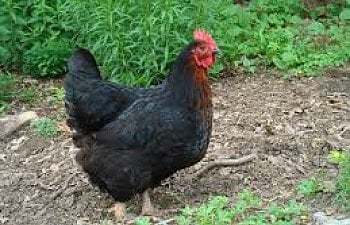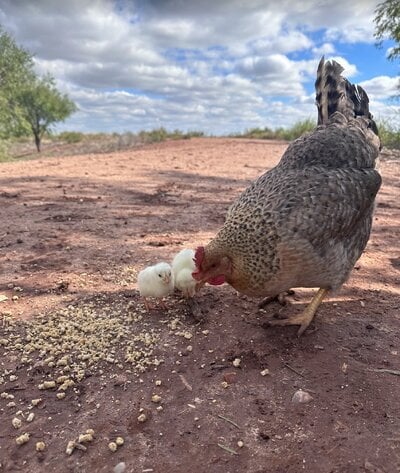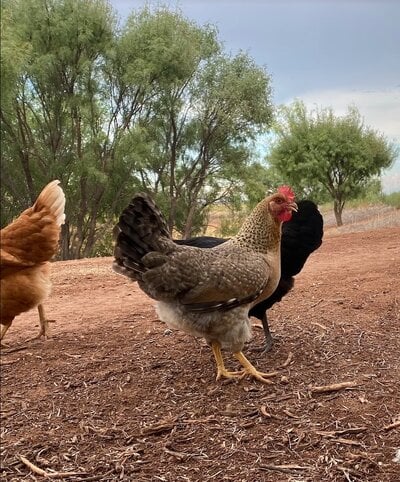Several people have asked me about this and i have found most sites leave out some important details. This article will explain how they are bred, and how to identify cockerels from pullets.
For the record i do not breed hybrid sex links typically on my farm. Excess males are usually a problem and hatcheries just dispose of them by whatever means necessary. On our farm, we feel that most of our chicks are to good for a dumpster. If we could find a way (or place) to donate the males for meat purposes, we would reconsider our policies on it.
What is a Sex Link?
Sex link chicks are basically chicks that can be sexed by their colors on the day they hatch. Most are made by crossing 2 different breeds with known characteristics to cause the coloring desired. Though they are usually bred for egg purposes, several make good meat chickens too. Most of the time if you switch the sexes from what is mentioned, the sex link will not breed through.
Different Types of Sex Link Breeding:
There are several different types of sex linked chickens, most do not breed true in second generations. These types include red stars, golden comets, red sex links, cinnamon queens, and black stars.
There are a few breeds that sex link characteristics carry through multiple generations, for example Rhodebars and Legbars. We will describe these breeds and their properties later.
Black sex link breeding:
Black sex links are created by breeding a barred hen to a non barred rooster. Typical breeding is a Barred Plymouth Rock hen under a Rhode Island Red, or New Hampshire red rooster. In this cross, the hens do not receive a barring gene (the barring gene is only located on the male chromosome.) The cockerels will inherit one barring gene from the mother (from her male chromosome). When the chicks hatch from this breeding, the males will have white dots on their heads, females will have all black heads. I put this in bold type as it is an edit, i had gotten ahold of some bad information.
As they grow, the males will look like barred rocks with some odd red feathering. Hens will appear mostly black with some red in their neck feathers.
Problems with breeding this sex link: you should use heritage chickens in your parent lines, most hatchery grade chickens have crosses that mess up the sex link properties. In your red rooster parent, look for red earlobes and dark feather coloring free from any white spots and light colored shafting. Your hen should show no signs of red feathers, and carry a descent quality barred pattern.
Sex link characteristics will not carry through if you try to breed the offspring.
 black sex link hen.
black sex link hen.
 black sex link rooster.
black sex link rooster.
Red Sex Link Breeding:
Several breeds are used in red sex link breeding, they are usually named by parents used.
Golden Comets are probably the best known, they are also bred wrong by most smaller breeders. I have even seen an advertisement on Craigslist for "full blooded Golden Comets". To have a full blooded Golden Comet is impossible. They are created by breeding a White Plymouth Rock hen to a New Hampshire Red rooster. When these chicks hatch, the males will be white, the females will have a red cast. The males will grow to be mostly white, with some red spots showing through, females will be mostly red with some white spots especially in the tails and lower wings. Most commercial strains use smaller parent birds for better feed to egg conversions.
The most common problems people have when trying to do this cross themselves is the silver gene needed in the White Plymouth Rocks. Hatchery stock New Hampshire Reds may have a cross in them that throws it off too. Chicks from White Plymouth Rocks that carry the silver gene will be smoky gray in color, and will be all white as adults. Another advantage of the silver gene is their feathers wont turn yellow in the sun like White Rocks bred without it.
 red sex link hen picture found here on BYC.
red sex link hen picture found here on BYC.
 red sex link rooster picture found here on BYC.
red sex link rooster picture found here on BYC.
ISA Browns are a form of red sex links that started from breeding Rhode Island Reds from Rhode Island Whites. Several other breeds have been added in over the years. They were created in the 1970's as battery hens by, Institut de Sélection Animale. They merged with Merck in the 1990's to form Hubbard. They make a good dual purpose breed, with hens producing 300 eggs in the first laying year. Female chicks have a red cast, males are mostly white. ISA browns are known to be territorial and usually do not make good pets. These must be bred under license from Hubbard.
Cinnamon Queens are another form of red sex link, and are usually easier to breed than Golden comets. They are created by using a Silver Laced Wyandotte hen, and a Rhode Island Red rooster. Male chicks will come out white, while hens are more red or brown in color.
A trick to breeding Cinnamon Queens may be to check earlobe color on parents and use red earlobes only. If you are gearing for egg production only use smaller framed parents for best feed to egg conversions.
You can also use Delaware hens and Rhode Island white hens, and several other breeds in sex link breeding.
Autosexing:
There are a few breeds that the sex link traits breed through multiple generations. Most of the surviving breeds were created in England, some have been imported to the U.S.A.
Brussbar: was created in England by crossing a Barred Rock and Brown Sussex. According to the Cobthorn Trust, they own the only known remaining brussbars with (last count i got from them) under 20 in the entire world. The Brown Sussex used in the breeding is almost as rare, with just a few hundred in the world. They are supposed to be excellent layers of brown eggs and large enough for meat production. I cannot find any information of how to sex them by color, but I am thinking the males will be light colored with a white dot on their head, like rhodebars. I am currently trying to import these into the U.S., P.M. me if you are interested in helping to preserve them.
 Picture of Brussbar cockerel, courtesy of Britannic Rare Breeds
Picture of Brussbar cockerel, courtesy of Britannic Rare Breeds
Legbar: was created in England by crossing Brown Leghorns, Barred Plymouth Rocks, and Araucanas. they lay a blue egg, and to the best of my research come in Gold and Cream varieties. Legbars are not the greatest layers, with approximatly 180+ eggs a year. The pictures below are of Crested Cream Legbars. The first 2 pictures are day olds, the 3rd picture is at 5 weeks. The males have lighter heads (right chick in center picture) Thank you "minihorse927" for the pictures.



Rhodebar: were created in England in 1947. They stared with Barred Plymouth Rocks and Rhode Island Reds, and were later crossed with Golden Brussbars. Rhodebars are supposed to be excellent layers of 200+ brown eggs a year. They should also make descent meat birds. The male chicks have a white dot on their heads and the females have a dark "chipmunk" stripe. The first picture is chicks owned by "eramsey99", the second picture is a younger trio of rhodebars grown by "cluckitall".


Welbar: Created in Great Britain in the mid 1941 by crossing gold and silver duckwing welsummer males with barred rock hens. These are very rare and I have had trouble obtaining pictures. They were bred in standard sizes and bantam sizes. Standard sizes make good dual purpose chickens. males will have a white dot on their head, females will not. It appears the bantam variety has survived best here in the U.S.A. This photo is courtesy of http://autosexing-poultry.co.uk

Wybar: created in England around the 1950's, they were bred as triple use birds. Egg production, meat production and exhibition. It appears the bantam variety has survived over the standard variety, but both still seem to be available in England. They were made by crossing Wyandottes with Barred Plymouth Rocks. I wasn't able to find a description of chicks, but I imagine the males have dots on their heads, and females dont. Photo of Wybar Bantams – courtesy of Philcott Poultry.

Cambar: The original line is now extinct. They were created in England by crossing Campines and Barred Plymouth Rocks. They were the first of the autosexing breeds developed at Cambridge.
Some links for more information:
http://en.wikipedia.org/wiki/Sex_link
http://www.feathersite.com/Poultry/CGP/Sex-links/BRKSexLink.html
http://autosexing-poultry.co.uk/wordpress/
http://www.chickenchatter.org/view_topic.php?id=316&forum_id=30
For the record i do not breed hybrid sex links typically on my farm. Excess males are usually a problem and hatcheries just dispose of them by whatever means necessary. On our farm, we feel that most of our chicks are to good for a dumpster. If we could find a way (or place) to donate the males for meat purposes, we would reconsider our policies on it.
What is a Sex Link?
Sex link chicks are basically chicks that can be sexed by their colors on the day they hatch. Most are made by crossing 2 different breeds with known characteristics to cause the coloring desired. Though they are usually bred for egg purposes, several make good meat chickens too. Most of the time if you switch the sexes from what is mentioned, the sex link will not breed through.
Different Types of Sex Link Breeding:
There are several different types of sex linked chickens, most do not breed true in second generations. These types include red stars, golden comets, red sex links, cinnamon queens, and black stars.
There are a few breeds that sex link characteristics carry through multiple generations, for example Rhodebars and Legbars. We will describe these breeds and their properties later.
Black sex link breeding:
Black sex links are created by breeding a barred hen to a non barred rooster. Typical breeding is a Barred Plymouth Rock hen under a Rhode Island Red, or New Hampshire red rooster. In this cross, the hens do not receive a barring gene (the barring gene is only located on the male chromosome.) The cockerels will inherit one barring gene from the mother (from her male chromosome). When the chicks hatch from this breeding, the males will have white dots on their heads, females will have all black heads. I put this in bold type as it is an edit, i had gotten ahold of some bad information.
As they grow, the males will look like barred rocks with some odd red feathering. Hens will appear mostly black with some red in their neck feathers.
Problems with breeding this sex link: you should use heritage chickens in your parent lines, most hatchery grade chickens have crosses that mess up the sex link properties. In your red rooster parent, look for red earlobes and dark feather coloring free from any white spots and light colored shafting. Your hen should show no signs of red feathers, and carry a descent quality barred pattern.
Sex link characteristics will not carry through if you try to breed the offspring.

Red Sex Link Breeding:
Several breeds are used in red sex link breeding, they are usually named by parents used.
Golden Comets are probably the best known, they are also bred wrong by most smaller breeders. I have even seen an advertisement on Craigslist for "full blooded Golden Comets". To have a full blooded Golden Comet is impossible. They are created by breeding a White Plymouth Rock hen to a New Hampshire Red rooster. When these chicks hatch, the males will be white, the females will have a red cast. The males will grow to be mostly white, with some red spots showing through, females will be mostly red with some white spots especially in the tails and lower wings. Most commercial strains use smaller parent birds for better feed to egg conversions.
The most common problems people have when trying to do this cross themselves is the silver gene needed in the White Plymouth Rocks. Hatchery stock New Hampshire Reds may have a cross in them that throws it off too. Chicks from White Plymouth Rocks that carry the silver gene will be smoky gray in color, and will be all white as adults. Another advantage of the silver gene is their feathers wont turn yellow in the sun like White Rocks bred without it.
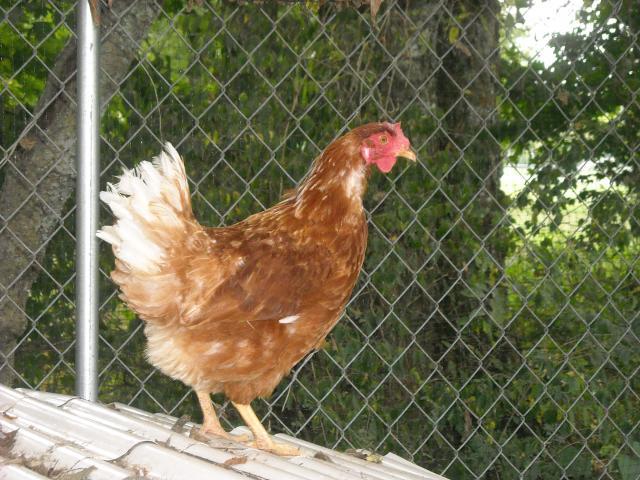
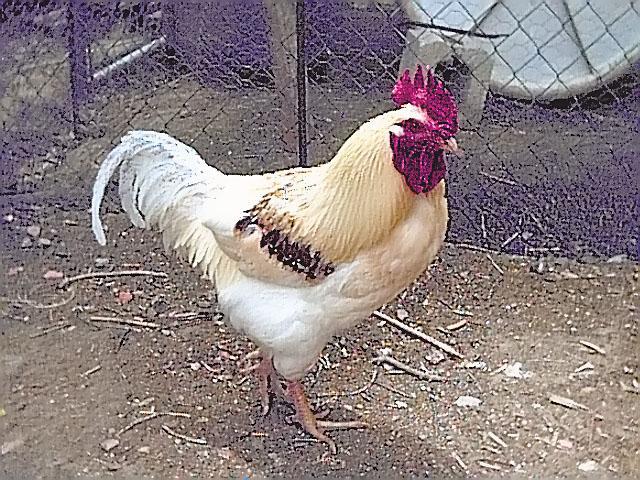
ISA Browns are a form of red sex links that started from breeding Rhode Island Reds from Rhode Island Whites. Several other breeds have been added in over the years. They were created in the 1970's as battery hens by, Institut de Sélection Animale. They merged with Merck in the 1990's to form Hubbard. They make a good dual purpose breed, with hens producing 300 eggs in the first laying year. Female chicks have a red cast, males are mostly white. ISA browns are known to be territorial and usually do not make good pets. These must be bred under license from Hubbard.
Cinnamon Queens are another form of red sex link, and are usually easier to breed than Golden comets. They are created by using a Silver Laced Wyandotte hen, and a Rhode Island Red rooster. Male chicks will come out white, while hens are more red or brown in color.
A trick to breeding Cinnamon Queens may be to check earlobe color on parents and use red earlobes only. If you are gearing for egg production only use smaller framed parents for best feed to egg conversions.
You can also use Delaware hens and Rhode Island white hens, and several other breeds in sex link breeding.
Autosexing:
There are a few breeds that the sex link traits breed through multiple generations. Most of the surviving breeds were created in England, some have been imported to the U.S.A.
Brussbar: was created in England by crossing a Barred Rock and Brown Sussex. According to the Cobthorn Trust, they own the only known remaining brussbars with (last count i got from them) under 20 in the entire world. The Brown Sussex used in the breeding is almost as rare, with just a few hundred in the world. They are supposed to be excellent layers of brown eggs and large enough for meat production. I cannot find any information of how to sex them by color, but I am thinking the males will be light colored with a white dot on their head, like rhodebars. I am currently trying to import these into the U.S., P.M. me if you are interested in helping to preserve them.

Legbar: was created in England by crossing Brown Leghorns, Barred Plymouth Rocks, and Araucanas. they lay a blue egg, and to the best of my research come in Gold and Cream varieties. Legbars are not the greatest layers, with approximatly 180+ eggs a year. The pictures below are of Crested Cream Legbars. The first 2 pictures are day olds, the 3rd picture is at 5 weeks. The males have lighter heads (right chick in center picture) Thank you "minihorse927" for the pictures.
Rhodebar: were created in England in 1947. They stared with Barred Plymouth Rocks and Rhode Island Reds, and were later crossed with Golden Brussbars. Rhodebars are supposed to be excellent layers of 200+ brown eggs a year. They should also make descent meat birds. The male chicks have a white dot on their heads and the females have a dark "chipmunk" stripe. The first picture is chicks owned by "eramsey99", the second picture is a younger trio of rhodebars grown by "cluckitall".
Welbar: Created in Great Britain in the mid 1941 by crossing gold and silver duckwing welsummer males with barred rock hens. These are very rare and I have had trouble obtaining pictures. They were bred in standard sizes and bantam sizes. Standard sizes make good dual purpose chickens. males will have a white dot on their head, females will not. It appears the bantam variety has survived best here in the U.S.A. This photo is courtesy of http://autosexing-poultry.co.uk

Wybar: created in England around the 1950's, they were bred as triple use birds. Egg production, meat production and exhibition. It appears the bantam variety has survived over the standard variety, but both still seem to be available in England. They were made by crossing Wyandottes with Barred Plymouth Rocks. I wasn't able to find a description of chicks, but I imagine the males have dots on their heads, and females dont. Photo of Wybar Bantams – courtesy of Philcott Poultry.

Cambar: The original line is now extinct. They were created in England by crossing Campines and Barred Plymouth Rocks. They were the first of the autosexing breeds developed at Cambridge.
Some links for more information:
http://en.wikipedia.org/wiki/Sex_link
http://www.feathersite.com/Poultry/CGP/Sex-links/BRKSexLink.html
http://autosexing-poultry.co.uk/wordpress/
http://www.chickenchatter.org/view_topic.php?id=316&forum_id=30

